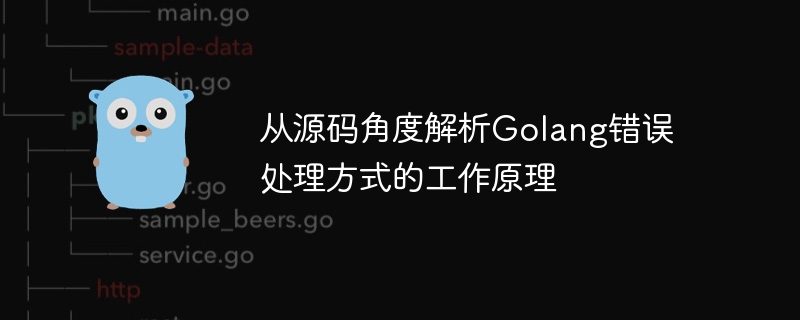Home >Backend Development >Golang >Analyzing the working principle of Golang error handling from a source code perspective
Analyzing the working principle of Golang error handling from a source code perspective
- PHPzOriginal
- 2024-03-14 09:03:04836browse

Golang is a programming language that is widely used in cloud computing, distributed systems and other fields. Its design is simple, efficient and easy to use, and the error handling mechanism is also one of its designs. . This article will analyze the working principle of Golang error handling from a source code perspective, and illustrate it with specific code examples.
1. Basic principles of Golang error handling
In Golang, errors are defined as an interface type error, which contains an Error() method for returning error information. Any type that implements the error interface can be treated as an error. Error handling in Golang is mainly implemented through the return value of the function. Usually the last return value of the function is an error type value. When an error occurs during function execution, the error information will be stored in a variable of this error type and return.
There are two main ways of error handling in Golang: one is to judge and handle errors through simple if statements, and the other is to delay handling of errors through the defer function. Below we use specific code examples to illustrate the working principles of these two methods.
2. Error handling through if statements
The following is a simple sample code that demonstrates error handling through if statements:
package main
import (
"errors"
"fmt"
)
func divide(a, b int) (int, error) {
if b == 0 {
return 0, errors.New("division by zero")
}
return a / b, nil
}
func main() {
result, err := divide(10, 2)
if err != nil {
fmt.Println("Error:", err)
} else {
fmt.Println("Result:", result)
}
result, err = divide(10, 0)
if err != nil {
fmt.Println("Error:", err)
} else {
fmt.Println("Result:", result)
}
}In the above example , the divide function is used to implement the function of dividing two integers. Use the if statement to determine whether the divisor is 0. If so, return a custom error message; otherwise, return the calculation result and nil to indicate no error. In the main function, we call the divide function twice and pass in different parameters for testing. If an error occurs, we use the if statement to determine whether err is nil. If it is not nil, the error message is printed, otherwise the calculation result is printed.
3. Delayed error processing through the defer function
In addition to the if statement, Golang also provides another elegant error handling method, which is to use the defer function for delayed error processing. Here is a sample code:
package main
import (
"errors"
"fmt"
)
func divide(a, b int) (int, error) {
if b == 0 {
return 0, errors.New("division by zero")
}
return a / b, nil
}
func main() {
result, err := divide(10, 2)
defer func() {
if err != nil {
fmt.Println("Error:", err)
}
}()
fmt.Println("Result:", result)
result, err = divide(10, 0)
defer func() {
if err != nil {
fmt.Println("Error:", err)
}
}()
fmt.Println("Result:", result)
}In the above example, we use the defer function to delay handling of errors. After calling the divide function, the defer function will be executed before the main function is completed, so that no matter whether the function makes an error or not, the error can be handled in time. Through the defer function, we can separate error handling logic from business logic, making the code clearer and more concise.
Summary
Through the sample codes of the above two error handling methods, we can see that Golang's error handling mechanism is designed to be very flexible and concise. Whether it is judged through if statements or delayed processing through defer functions, errors can be effectively captured and handled to ensure the robustness and stability of the program. For developers, rational use of Golang's built-in error handling methods can make code easier to write and maintain, and better respond to various abnormal situations.
The above is the detailed content of Analyzing the working principle of Golang error handling from a source code perspective. For more information, please follow other related articles on the PHP Chinese website!

